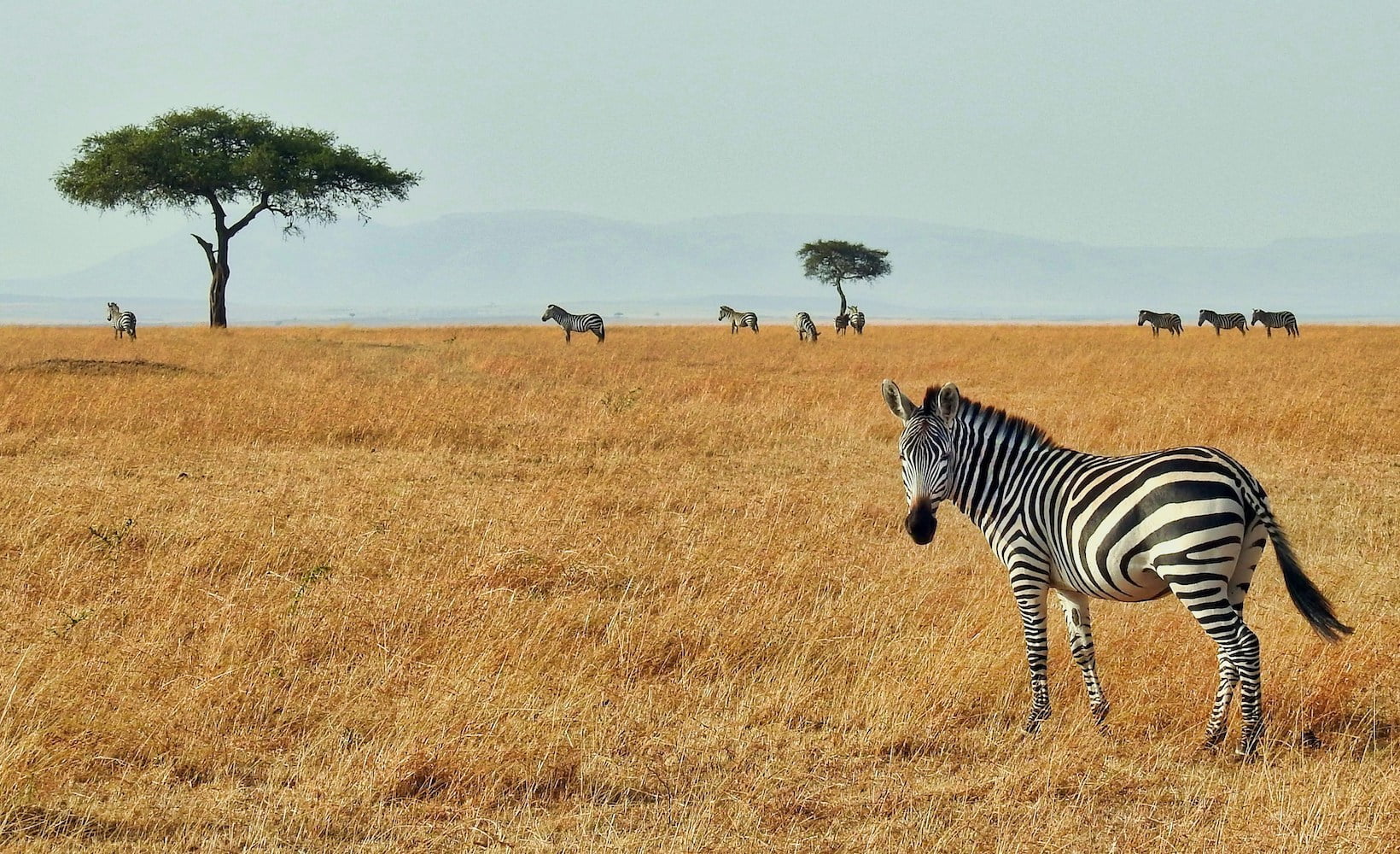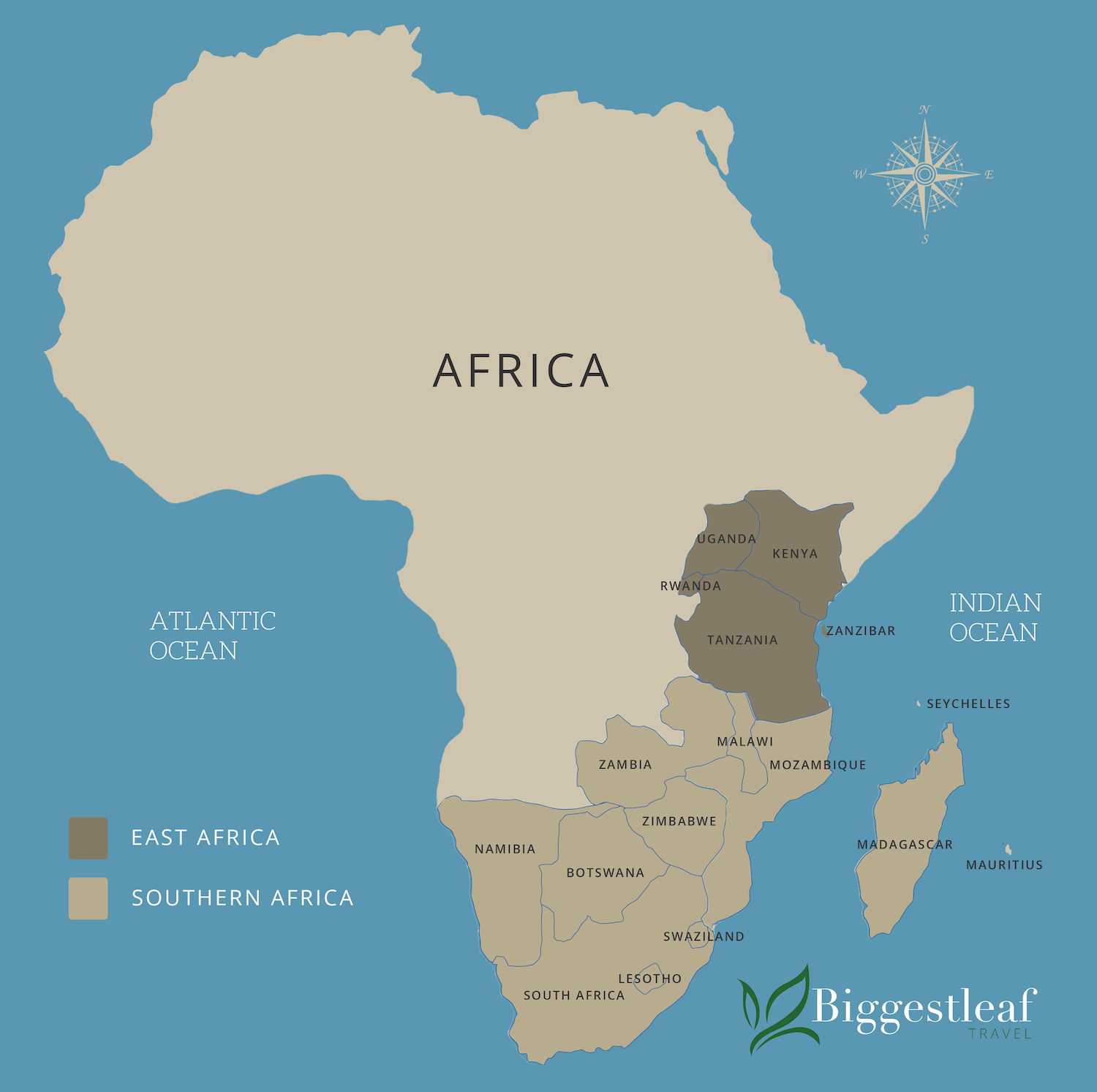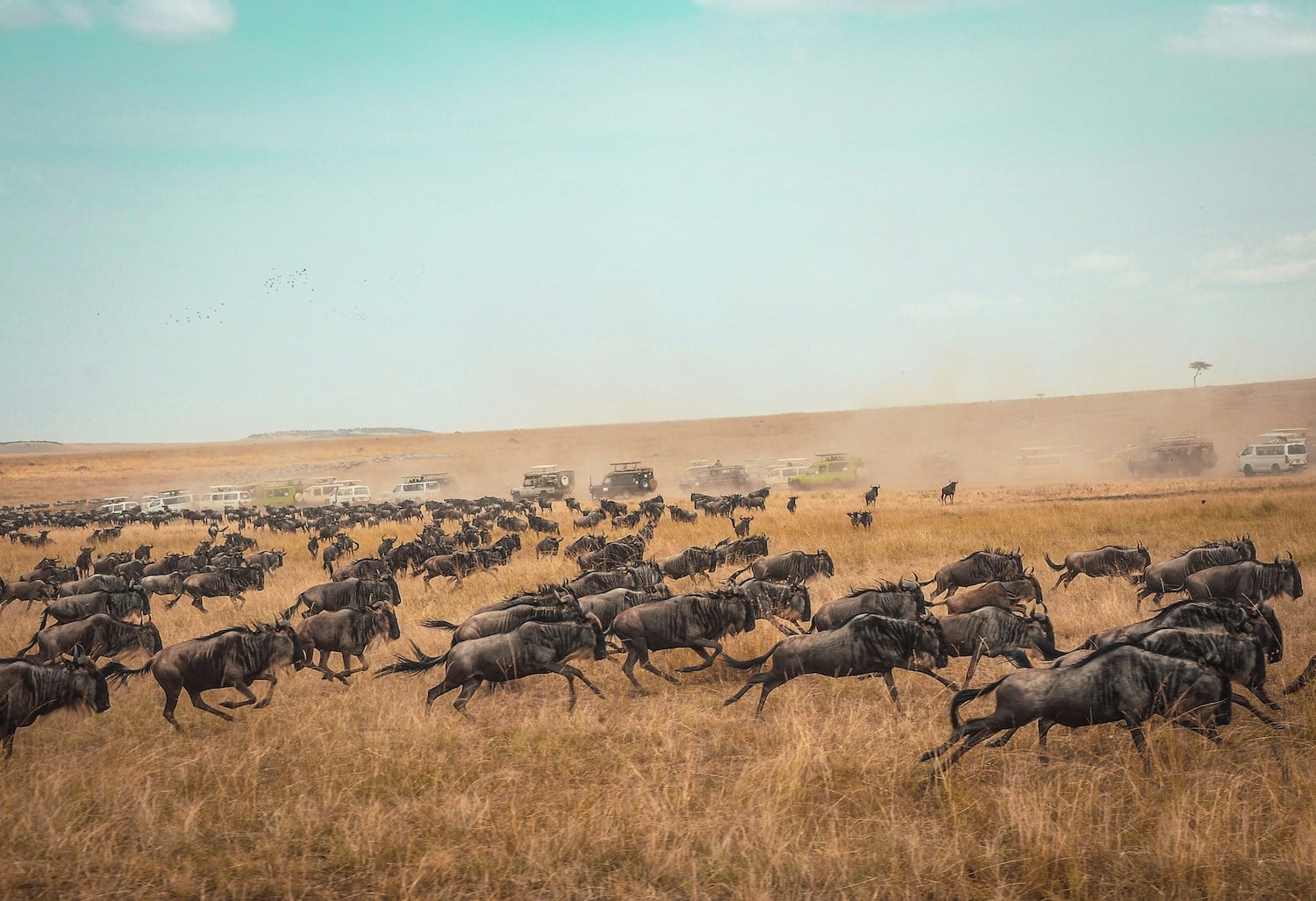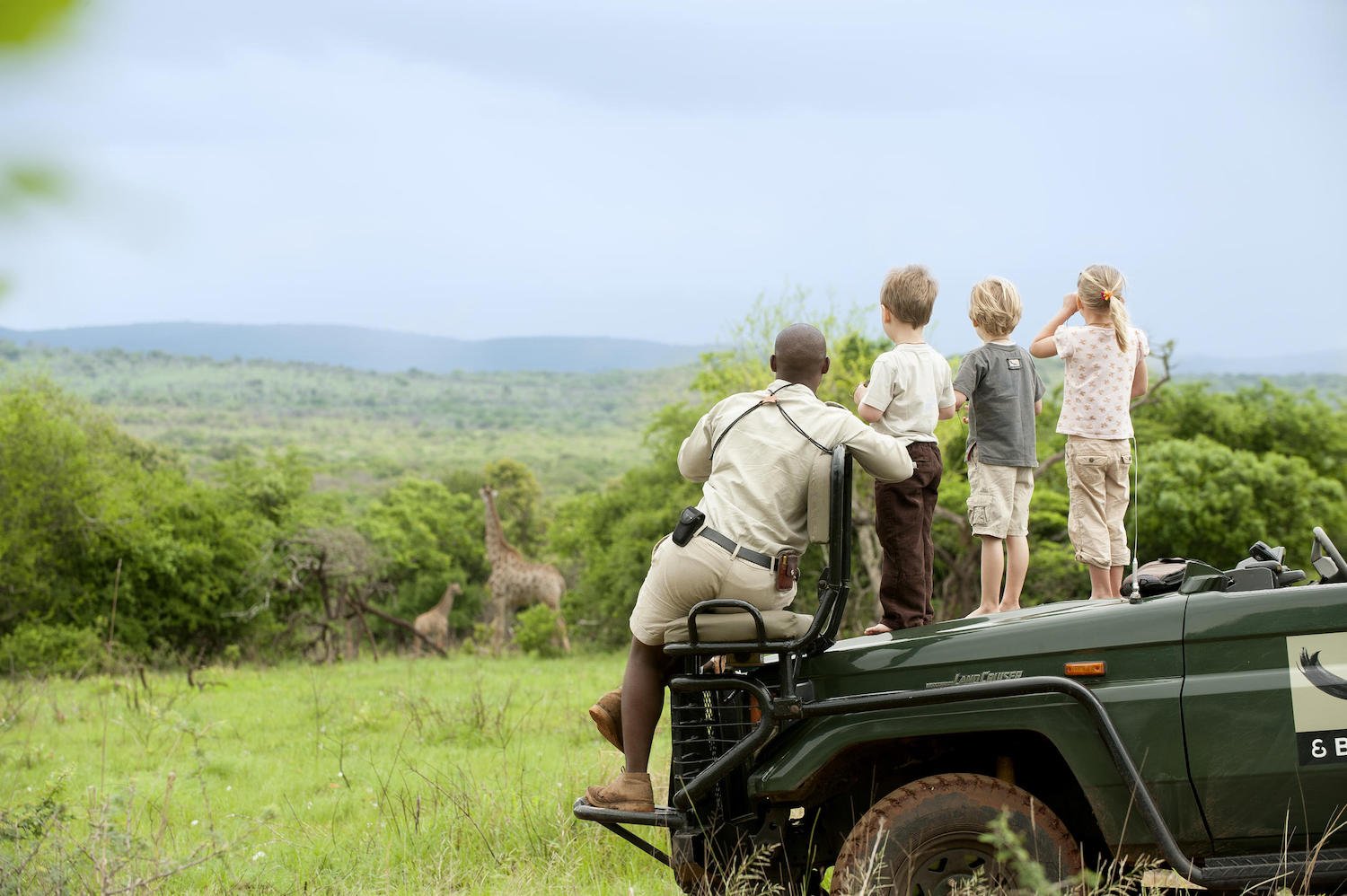What are the differences between East Africa and Southern Africa?
Africa is a vast continent with many protected wildlife areas. Most safaris occur in either East Africa or Southern Africa. This is our expert breakdown of how each region differs so you can make an informed decision. Remember, there is no ‘best’ or ‘worst’ – just differences!

Zebra grazing in the Masai Mara ~ Kenya, East Africa
What’s covered in this guide
Explore the highlights of this post with ease by using the table of contents below to navigate to sections of interest.
Map

East Africa comprises Kenya (the Masai Mara), Tanzania (the Serengeti), and Rwanda and Uganda (gorilla trekking) as well as islands like Zanzibar and the Seychelles.
Southern Africa comprises South Africa (Kruger), Botswana (the Okavango Delta), Namibia (Etosha), Zambia (South Luangwa) and Zimbabwe (Hwange) as well as the Victoria Falls and islands like Madagascar and Mauritius.
Quick Summary
- Choose East Africa for savannah, the Wildebeest Migration or gorilla trekking.
- Choose Southern Africa for the Big 5, boating activities or walking safaris.
- Both are suitable for family vacations or honeymoons.
- Both have wildlife strongholds, big cats and phenomenal sightings.
- South Africa has the largest rhino population.
- Kruger, the Okavango, Victoria Falls, Cape Town and Table Mountain are all in Southern Africa.
- The Serengeti, Masai Mara and Ngorongoro Crater are all in East Africa.
Landscapes
East Africa
- The Serengeti and Masai Mara are actually one huge continuous piece of land split by the Tanzania-Kenya border. It comprises classic, open golden savannah with occasional trees dotted around. This makes it much easier to see wildlife as there is not a lot of foliage for them to ‘hide’ in. The great Wildebeest Migration takes place here.
- The flatness and openness of the landscape suits cheetah.
- Because it is easy to spot game, the Serengeti National Park and Masai Mara National Reserve are very popular and day visitors are allowed in.
- The Samburu region of Kenya is drier with different species being supported by a more arid environment.
The Selous and Ruaha areas of Tanzania have more forest and baobabs.
The Ngorongoro Crater is a renowned game-viewing part of Tanzania, which is also home to Mount Kilimanjaro, the highest freestanding mountain in the world.
Southern Africa
- Because it consists of so many different countries, Southern Africa has a wealth of landscapes including desert and semi-desert in Namibia, wetland in Botswana, grasslands and woodlands in Zimbabwe and Zambia, and thicket in South Africa.
- There are many famous rivers like the Zambezi, Luangwa and Chobe, making for varied water activities.
- Southern Africa is also home to world famous landmarks like Table Mountain and the Victoria Falls.
Rule of Thumb
The more ‘open’ a landscape, the easier it is to see wildlife. This also makes it much more popular and so there may be more visitors and vehicles. The more ‘closed’ a landscape, the more rewarding it is to find animals. Bear in mind that not all species exist in all landscapes: you will not find hippos in Etosha or rhino on the Serengeti.
Activities

Watching the wildebeest is a very popular spectacle in East Africa.
East Africa
Game drives generally only have a guide.
- Game-drive vehicles tend to have pop-up roofs and windows.
- Because of the open landscapes and many suitable launch and landing spots, hot-air ballooning is popular across the Mara and Serengeti. This early-morning activity gives you a bird’s eye perspective on the sheer vastness of wilderness below.
- Night drives, nature walks and off-roading (leaving the road to get closer to special sightings) are only possible in private reserves or conservancies.
- Boating is limited to areas like Nyerere National Park and Selous Game Reserve in Tanzania.
- The beaches and islands of Kenya and Tanzania are idyllic places to relax after the early mornings of safari.
- Gorilla and chimp trekking are only available in Uganda and Rwanda (Congo also offers gorilla trekking).
Southern Africa
Many lodges offer a guide and a tracker or spotter, whose sole job is to look out for animals (this is because of the denser foliage found in many areas).
- Game-drive vehicles tend to be open with no windows.
- Ballooning is limited and seasonal because there are fewer suitable launch and landing sites. There is some ballooning in Namibia and over the Pilanesberg in South Africa.
- Night drives, nature walks and off-roading are possible in private reserves and concessions.
- There is a lot of boating and kayaking in Southern Africa especially around Mana Pools, Lake Kariba, Chobe, the Panhandle and Lower Zambezi.
- Mekoro rides in traditional dugout canoes are a highlight of safaris to the Okavango Delta.
- In addition to marvelling at the world’s biggest sheet of falling water, Victoria Falls is also Africa’s adventure capital with thrills like bungee jumping, bridge swinging, swimming in Devil’s Pool and some of the world’s best white-water rafting.
- Zambia is home to world’s top walking safaris, where you walk from camp to camp over several days.
- Botswana’s Makgadikgadi Pan is home to habituated meerkats, who will climb all over you to use you as a lookout post.

Spotters or trackers often help find game in Southern Africa.
Rule of Thumb
Safaris are full of options when it comes to activities. Chat to your Biggestleaf consultant about what you hope to get out of your holiday: plenty of relaxation, being very active or having lots of special activities that must be pre-booked.
Culture
East Africa
- The conservancy system – where traditional landowners or villagers lease their tribal or ancestral lands to safari operators – means that you can drive through villages (‘manyatta’), see livestock and encounter indigenous culture across much of Tanzania and Kenya.
- The Masai and Samburu cultures are very strong across Kenya and you may encounter Maa and Samburu people in their fine beadwork, traditional cloaks (‘shukas’) and sandals made of tyres.
- In parts of Tanzania, it may be possible to spend time with the Datoga and Hadzebe.
Southern Africa
- Apart from a few areas, wildlife reserves tend not to have human habitation and, unless you do road transfers, you are unlikely to come across many traditional villages.
- The staff at many lodges will sing traditional songs to welcome you and bid you farewell.
- Many operators are phasing out school or village visits as they are disruptive and sometimes considered insensitive.
- In parts of Botswana and Namibia, it is possible to spend time with the San Bushmen or Himba. In South Africa, you may be able to spend time with Zulu or Xhosa people.

The Maa people have long inhabited the Masai Mara in Kenya.
Rule of Thumb
If authentic cultural experiences are important to you, your Biggestleaf consultant can look at ways of building them into your itinerary. Please note that you should always ask before photographing people – especially children – or their homes.
Accommodation and Amenities
Across East and Southern Africa, lodges and camps can be extremely luxurious or refreshingly basic (but never sacrificing comfort or safety). Both offer everything from brick-and-mortar cottages to mobile camping.
- The overall food and wine offering in Southern Africa is generally of a slightly higher standard than East Africa (unless you are staying at top lodges) but this is only because much of the produce and most highly trained chefs come from South Africa.
- Like accommodation, amenities can vary widely across both regions. If it is important to have reliable Wi-Fi, a private pool or access to a spa, your Biggestleaf consultant can arrange all of these for you.
Family friendliness
East Africa
Many lodges and camps will accept children, generally over the age of six. A private game-drive vehicle may have to be hired in this case.
- Teenagers under 16 may not join gorilla trekking and both Uganda and Rwanda are not generally suitable destinations for children.
Southern Africa
In general, there are more family units (that can sleep four or more) in Botswana and South Africa. There also tend to be more triple rooms ie where another bed can be added so a child can share with their parents.
- Many lodges in South Africa have nannies, babysitters and kids’ clubs, usually at an extra cost.
- There are many more private safari villas in Southern Africa with private chefs, vehicles and guides as well as pools and kitchens that accept children of all ages.

Southern Africa is geared up for kids.
Rule of Thumb
Children are loved across Africa. We have gone on safari with children of our own and so understand the unique needs of parents. Whether you choose East or Southern Africa, we will be able to put you in a lodge where they will have fun and feel safe.
We’re Experts, We Can Help
Whether you know which countries you’d like to visit – or not yet – chat to us about making your safari come true. We’ve travelled extensively ourselves and pride ourselves on working with clients to ensure the best possible holiday for the best possible cost. Our Trustpilot reviews prove it!
PHOTO CREDITS &Beyond and Ron Dauphin, Harshil Gudka, Sebastian Quavers, Andrew Liu and Elliot Paris (all Unsplash)








